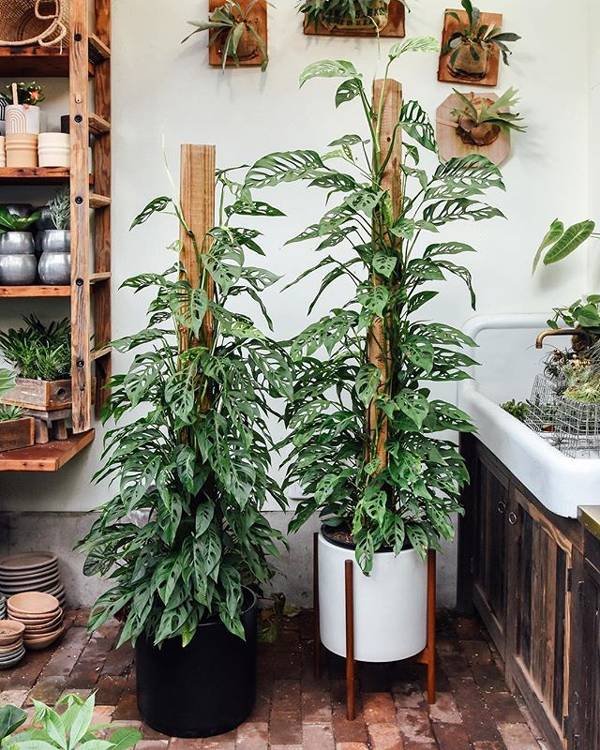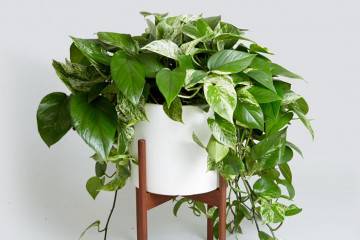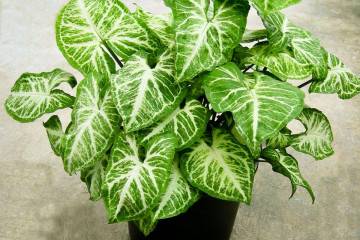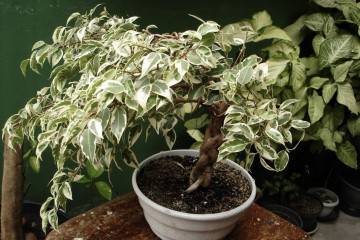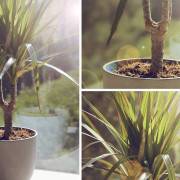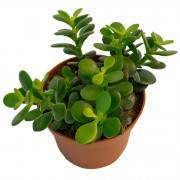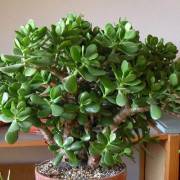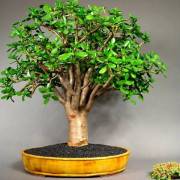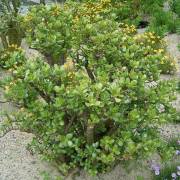How to transplant a monster at home
Content:
When the discoverers, stepping on the American coast, saw giant trees with cuts in the leaves, they called the find "monsters". The strangers experienced a particular fear, observing such a phenomenon characteristic of the monstera as air roots. Having formed along the entire length of the trunk, the rootlet, having reached the ground, took root there in order to continue development. Some roots appeared at high altitudes and continued to develop, reaching any support that stood in their way. Almost the same thing happens in the apartment.
Description of the flower
Monstera is an evergreen tropical vine. Its homeland is considered to be the territory adjacent to the equator of the southern and central parts of the United States. In the wild, the height of adult specimens reaches 45 m.
Modern plant breeders from all over the world know how to grow a monster from seeds, cuttings and even leaves. But today we will talk about how to transplant vines.
How to transplant and care for a monster
The health and further development of the vine depends on how the transplant is carried out. The transplant is carried out in the spring. Young specimens need an annual transplant. Adults who have reached the age of four do not transplant.
The powerful root system of the vine grows over time and requires more and more space. Therefore, the transplant should be carried out into a more spacious vessel. In a cramped flowerpot, the monstera will wither away.
The pot, in which the vine has grown for a whole year, is turned upside down to check if the roots have penetrated the holes made in the bottom. In this case, it is important to ensure that the open part of the pot is placed in the palm of your hand, and the few branches of the young monstera pass between the fingers of the hand.
How to transplant a monster at home step by step? If the roots are not stuck in the bottom holes, it will not be difficult for the monster to take it out of the pot in a place with a lump of earth in which it developed. Before transplanting into a large container, it is necessary to clear the earthen lump from the top layer. This should be done gently with your fingertips. After transplanting, the top layer is renewed by adding a little fresh soil.
Upon reaching the age of 4, the liana transplant can be stopped, limiting itself to updating the top layer of the soil. Carefully, so as not to damage the roots, the top layer is removed and a fresh one is poured in its place. Thus, the soil is partially renewed.
Monstera feels great in ordinary soil, which includes humus, sand and a small amount of sod land.
Specialist recommendations on how to transplant a monster
Experienced flower growers have collected several tips, thanks to which even beginners will be able to transplant monstera at home.
Before transplanting, a new pot must be prepared:
- drainage is placed on the bottom of the container, for example, expanded clay or pebbles;
- a handful of soil is poured over the drainage, in which the young plant grew during the previous year.
Do not immediately fill the pot with a lot of earthen mixture. Having immersed the monstera in a new container, the grower conveniently places it in a new flowerpot and only after that he adds fresh soil. As a result, the bush should be securely fixed, but not pinched.
The favorite places of the tropical liana are well-lit, but shaded areas with high air humidity. Those varieties are especially demanding on lighting, the leaves of which are crossed with white or yellow stripes. All types of monstera prefer diffused light.
Construction of an additional support
Newbie growers are interested in the question: how to properly plant a monster that has reached 4 years of age, once and for all. In order for the vine to gain a foothold in the ground, it will need additional support. It could be an ordinary stick.
Professionals use a pipe with a diameter of 5-7 cm wrapped in coconut fibers as a support. It is attached to the trunk with twine or a special twine for tying vegetables. Monstera will eventually cling to the support and, having released air roots, will wrap around it.
How to choose a pot
In many ways, the future life of a developing monstera depends on whether the pot for the monstera is chosen correctly. The new flowerpot should be large and spacious so that the vine can freely fit in it along with the pot in which it developed during the previous year.
The planter option is only suitable for young seedlings. Monstera develops too quickly, clinging to the smallest protrusions in search of support. It is impossible to tear off an adult liana from a ledge in the wall or hanging cabinets without harming it.
Daily care rules
Monstera needs feeding from April to August. Fertilizers are applied every 7-10 days. Experienced growers fertilize the monstera with a purchased mixture, suitable for all types of decorative deciduous trees.
As they grow older, the root system grows, and some roots break through to the surface. The task of the grower is to notice such forays in time and direct the roots deep into the pot.
Water the monster in moderation, regardless of the season. Pour the liana with settled warm water. In summer, water treatments in the form of spraying and a warm shower are desirable. This is especially true of the graceful monstera. In winter, flower growers wipe the leaves of the vine with slightly warmed water.
Monstera is a smart vine. She constantly communicates with the owner, giving a kind of signals. If a plant breeder can decipher these hints, he will be able to grow a monster as majestic as it can be found in the wild.
This is how the monster signals:
- the appearance of dark brown dry spots on the leaves is a clear sign that the monstera suffers from dry air;
- wet dark spots - the consequences of too hard watering, which does not benefit the vine;
- yellowing of foliage is a signal that there is too much moisture.
With age, the vine loses its attractiveness, the lower foliage falls off, exposing the trunk.In order for it to grow again, at the beginning of spring, the upper part of the stem is cut by about 30 cm so that there are 2-3 leaves on the cut area. Thanks to this manipulation, the lower part receives an additional portion of minerals, and the branches grow back again.
The cut off top can be germinated in warm water, and then transplanted into a separate container. Air roots are formed first, and then the development of the lower root system begins. To propagate a vine, it is enough to separate the top leaves, germinate them and plant them in different pots.
A plant breeder who has set himself the goal of growing a beautiful monster should not forget about the parasitic tendencies of this species. The pot with the plant itself and the adjacent areas of the dwelling must be systematically inspected in order to prevent damage to property. If the monstera senses that there is an additional support nearby, for example, a piece of peeled wallpaper or any piece of furniture, it will surely catch on to the nearest ledge and continue to develop.
That's all! Those who want to grow this flower should re-read the article again in order to know what to prepare for and what to stock up on. Only then can you go to the flower shop for the "monster".

